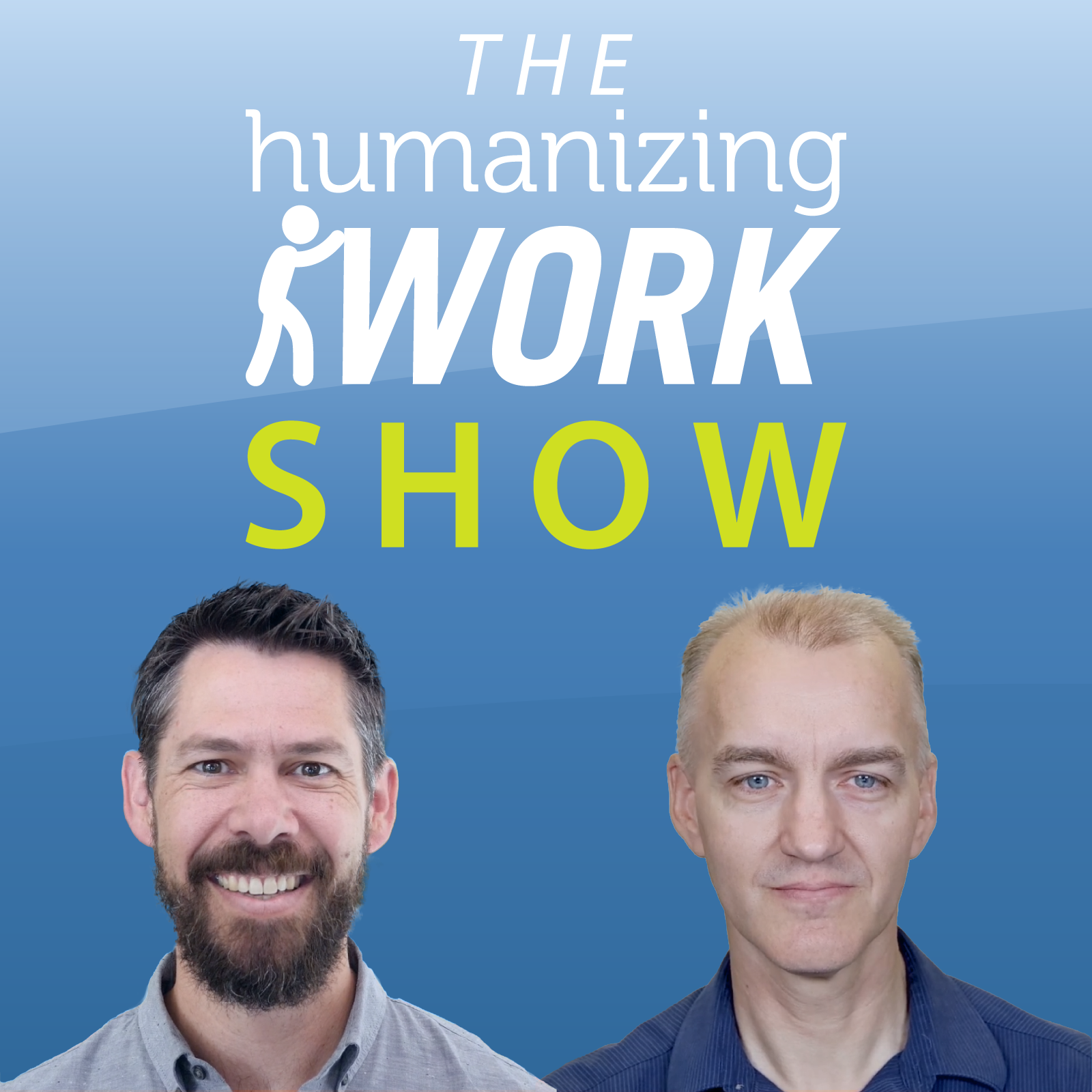Episode Transcription
Richard Lawrence
Welcome to the Humanizing Work Show!
Today’s episode describes how a Scrum Team’s Daily Scrum, or daily stand-up, if you’d like, is a snapshot into the overall health of a team.
Peter Green
Before we jump into today’s episode… We want to help you with whatever challenges are most frustrating you right now. If you’re feeling stuck on something, whether that’s trying to take a more human-centric approach to your work, trying to make your product or business outcomes better, or if you’ve just got a more tactical, process-related question, let us know about it. Send us an email at
[email protected] with a few details about the situation, and we’ll share how we might think through your challenge right here on the Humanizing Work Show.
Richard
And just a quick reminder to rate and review the Humanizing Work Show in your podcast app, or if you’re watching on YouTube, please subscribe, like, and share today’s episode if you find it valuable to you. Your help spreading the word is super meaningful to us!
Peter
And if you want to get access to more content we produce, not just the show, you can sign up for our free newsletter where we share one key idea every week. Sign up at humanizingwork.com/hwnews.
When I was leading Adobe’s agile transformation, I used to do an annual survey that I sent to all of the teams that had adopted Scrum. I had two main questions I was curious about that caused me to start sending out the survey. First question: “Are people actually using Scrum?” I had taught them about this stuff– did they actually use it? And the second question, probably even more important, “If they’re using it, is it working for them?” So, the survey had two sections, one that assessed whether the person’s team was actually using Scrum, with questions around specific Scrum practices and some additional other agile techniques beyond Scrum, and then another set of questions around whether the person’s team liked Scrum and were getting benefit from using it. As I gathered more data, I started looking for correlations between specific parts of Scrum and whether people thought it worked well for them. The interesting thing that stood out for me, the strongest correlation I found between a positive implementation of Scrum and a specific Scrum practice, was around the Daily Scrum. When people reported that the Daily Scrum was an effective use of their time, they were almost certain to also report that they liked Scrum and Scrum seemed to work well for their team.
Now, I don’t think this means that if we just facilitated the Daily Scrum better, that the rest of Scrum would magically fall into place. To say it another way, the relationship between a good Daily Scrum and Scrum working well wasn’t causal, it was correlated. The Daily Scrum was the proverbial “canary in the coal mine,” a quick, lightweight glimpse into the overall health of the broader system around that team. Healthy teams rarely have bad Daily Scrums. And bad Daily Scrums rarely happen on healthy teams. If your Daily Scrum feels like a waste of time, that’s probably not your biggest problem.
Richard
Yeah, I had the same realization from the other direction. I used to do a lot of in-person coaching with teams that I’d trained, or a colleague had trained. I discovered that just from watching a 15 minute Daily Scrum I would generate hypotheses about the overall health and effectiveness of that team that would inevitably be confirmed by more in-depth coaching. Eventually, this pattern had become so strong that I’d prefer to start working with a team I was coaching by observing a Daily Scrum rather than hearing a ScrumMaster’s or manager’s take on how things were going. They’d want to tell me what was going on, and I’d often stop them and say “Hold up. Let me observe a Daily Scrum, and then we’ll talk about it.”
So, let me share some of the things I would be watching for as I got more intentional about this, and then the larger things they often correlated to, and you can use that to think about “What would I see on my own team, in our daily meetings?”
The first thing is “How does the Product Owner interact with the rest of the team?” Sometimes it’s as simple as, “Does the Product Owner even come to the Daily Scrum, and when they come to the Daily Scrum, do they look like a member of the team collaborating around the same kind of problem, or do they look like somebody who is giving orders to the team or checking in on status? Does the Product Owner plan with other team members how they’re going to collaborate that day around items in the current sprint or items on the backlog that need refinement? So you can tell a lot about that relationship just in a few minutes.
Similarly, how does the ScrumMaster interact with the rest of the team? Are they the person who seems to be just in charge of the process, or the Project Manager keeping track of the status of things, or do they feel like they’re somebody who’s really there almost behind the scenes helping things go well on the team and helping work flow smoothly?
Is there a sense of the team working toward a shared commitment? This shows up in how the team talks about the work. Are they talking about larger things they’re trying to accomplish together and collaborating around, or is each person just reporting how busy they are on their individual tasks? By the way, the default approach to the daily Scrum that many teams often do, where each person reports on yesterday, today and impediments, often moves away from this sense of a shared commitment. So we often suggest focusing on the work itself rather than individual tasks. And we talk about that in our Daily Scrum episode, which we’ll mention later.
Is the team often waiting for others outside the team to meet their commitments? You’ll find out in the Daily Scrum, things get blocked, waiting on outside dependencies. This may tell you something about whether the team even has the right skills on it.
How much does the sprint backlog get interrupted? This one’s a little nuanced. The team that has no interruptions might be healthy, or they might just be ignoring change. There are genuine emergencies they need to address and they keep them away, which may not be healthy– but you also see teams that are completely overwhelmed with interruptions and changes; and so I want to see some healthy amount of “Yeah, things change– the world is complex and unpredictable–but we’re still focusing on our core shared commitment.” Check out our previous episode on how to deal with interruptions on a Scrum Team if you have a mix of planned work and emergent interruption kinds of work, by the way.
Do people ask for and offer help? This is a signal about how much team members trust each other and how much they have a sense of “We’re in this together and we need to work together on it.” If people say “I’m stuck on this thing, but I’m going to keep working on it,” or if they don’t even bring it up, they say “Yeah, I’ve been stuck on that for a few days,” they’re probably not high trust, high safety, high collaboration. If instead it’s “Yeah, I’m starting to get stuck on that, can somebody work with me right away this morning to get me unstuck?” that feels like a team that’s working together on something.
A couple more: Does the plan change? This turned out to be one of the key indicators of a healthy daily Scrum and often a healthy team. If everyone shows up with a plan for what they’re going to do for the day, they report on the plan and they do the thing they originally planned, you didn’t really need a meeting. But If the team gets together, surfaces the shared things they have learned over the last day, and then, together, uses that information to plan the best day today, that feels like a team that’s collaborating around complex problems. The plan doesn’t need to get blown up every day, but I want to see some amount of “We’re responding to things that are emerging on our team, and our daily scrum is really based on ‘What we know now, how do we make today matter?’”
Finally, the last thing; I was watching to see if there is a healthy balance of things we need to discuss and decide together as a whole team, vs things we can discuss in smaller groups to address. You often end up with a really long Daily Scrum meeting if everybody feels like they need to be involved in the details of everything, and that’s not always healthy on a team. So, some amount of “We raise an issue and then two or three people say, “We’ll take that on,” and everyone else trusts them to do it,” is pretty healthy on a team, especially if, day to day, those groups are kind of dynamic and different people are working together.
Peter
Yeah, Richard, I agree with all of those, and it reminded me of an experience I had one time.
So, I had done, when I was working for Adobe, a lot of training for some really great teams in India, in the Noida Campus. And one of those teams I had trained a few years prior to this visit that I was on in India, and I remember the ScrumMaster saying, “Hey Peter, welcome back. It's great to see you. It’s been a couple of years. Would you mind coming and giving some coaching to our team while you’re here?”
And, it’s funny, we had never talked about this before, but I took the exact same approach. I said, “Well, when’s your Daily Scrum?” I wanted to go observe the Daily Scrum. So he said “Hey, our Daily Scrum is at such and such a time,” and I was available. So I walked into this meeting area, and the Daily Scrum was about to start; and as people came in, they formed a circle. So they were standing in a circle for the Daily Scrum. And then, the coolest thing I think I've ever seen in a Daily Scrum happened.
Srinath, who was the ScrumMaster, did not stand in the middle of the circle, which was kind of what I was expecting. Instead, he would go and stand behind the individual who was about to share, “Hey, you know, yesterday I was workin’ on this thing, and here’s how it went, and today I’m a little blocked…” like, the normal report.
And instead of standing in the the circle, where that person might look at Srinath as an authority, and share the report to Srinath the ScrumMaster, Srinath would stand behind that person and occasionally would even put his hand on his shoulder, like in a supportive gesture, and they would share their report. And then the next person– he would move over and stand behind him, so that they couldn’t report to him. And this was so cool, because a lot of times, especially in cultures like kind of a traditional Indian culture, when there’s any kind of sense of authority, it’s really strong. And Srinath wanted to deemphasize that in his role as a ScrumMaster: that “I’m here to serve you. You are not here to report to me.” And I thought, just that simple gesture of “I’m going to stand behind you so you can’t look at me when you give your report, and I’m going to support you in that,” was really cool, and was a great of example of not only a snapshot of a very cool practice that that team had adopted, but I knew Srinath, and I knew that he was very mindful about these things, and that was an example of them modifying their Daily Scrum over time. You could almost imagine what the first Daily Scrum was like with that team, where they were standing in a circle, and everybody did report to Srinath,and he was saying, “Boy, how could I get them to not report to me? What if…?” So, it was cool to see that progress.
Richard
Along those lines, we’ve mostly focused here on the Daily Scrum as a team diagnostic—how the Daily Scrum tells you about the larger health of a team. But Peter’s story is a nice example of how you can use the Daily Scrum and small changes on the Daily Scrum to shape changes in your team’s health. For more on how to facilitate a Daily Scrum that gets your team collaborating around a shared commitment, check out our Daily Scrum episode from back in January. [https://www.humanizingwork.com/daily-scrum-episode/].
Peter
Please like and share this episode if you found it useful. Let us know what you notice as you start paying attention to your daily scrum.




